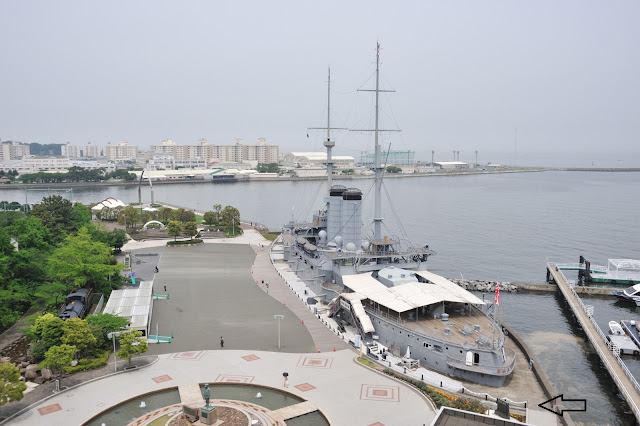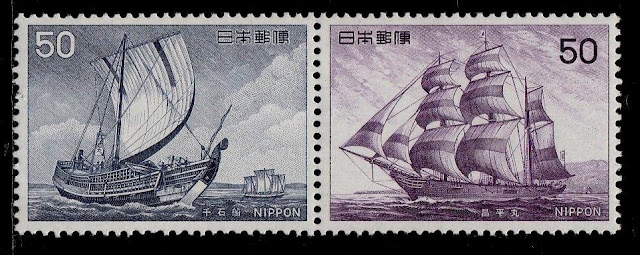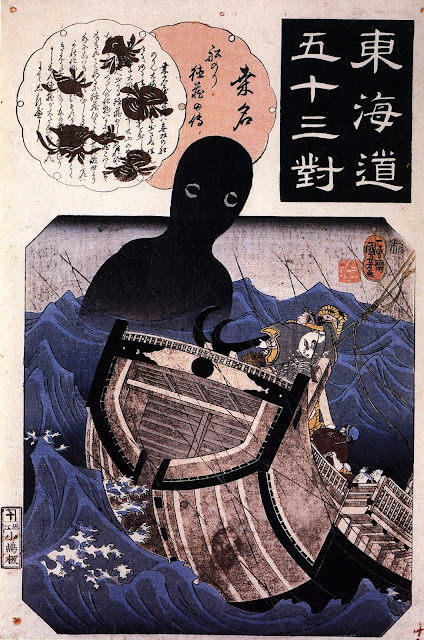 |
| Gunkan March written in calligraphy. Image : JMSDF |
You might be familiar with military marches such as " Anchors Aweigh " of the US Naval Academy or the British " Colonel Bogey " march adopted in the 1957 film " The Bridge on the River Kwai ", but have you heard of Japan's number one military march, the Gunkan Koshinkyoku?
The Gunkan Machi ( 軍艦マーチ ), officially known as the Gunkan Koshinkyoku ( 軍艦行進曲 ), is a military march composed in 1897 by Setoguchi Tokichi. Translated, it is invariably known as the Warship March or the March " Man-Of-War ". It was the official naval march of the Imperial Japanese Navy ( IJN ) and currently that of its modern day successor the Japan Maritime Self-Defense Force ( JMSDF ).
It has a storied past in its more than a century of existence and was banned for a few years by the US occupation forces after World War II, in part due to its controversial imperialistic and militaristic lyrics. The march was resurrected with the formation of the JMSDF and is frequently played during ship naming and launching ceremonies for both warships and sometimes merchantmen as well. In post-war Japan, this much beloved tune continues to endear Japanese hearts and can found in CD compilations and can be heard as background music streaming from pachinko machines and arcade video game consoles.
It even has a commemorative monument erected in its honour at the Mikasa Park in the port city of Yokosuka, and that is an uncommon feat. How many of the world's great marches have had their own monument? And did I mention that this march has such a catchy rhythm and tune that even the Chinese could not resist using it during one of their graduation ceremony? But more of that later.
We can begin by listening to the Gunkan March being played by the JMSDF Band, Tokyo at the Tokyo Opera City at the 50th Regular Concert in 2011. The video can also be accessed here.
The Gunkan March
I honestly could not recall when I first heard the Gunkan March being played but it was likely a few years ago when watching one of the launching ceremony of a Japanese warship. After listening to it a few times being played on different events, it must have dawned on me that this had to be some official tune sanctioned by the JMSDF. The more I listened to it, the more appealing it became. I was so intrigued by it that I started to research on its origins and history, and what a treasure cove of information I discovered.
The Gunkan March could have its origins traced to lyrics written by the multi-talented educator, naturalist and lyricist Toriyama Hiraku ( 鳥山啓 ) in 1893 entitled " Man-of-War " ( Gunkan ). It was made into a military song with music composed by Yamada Genichiro and was selected for the Compilation of Elementary School Songs edited by educator Isawa Shuji ( 伊澤修二 ). You can listen to this original Gunkan military song set to a very different tune and tempo here. If the song does not play automatically, right click on the black bar below the photo of the songbook and select reload frame.
 |
| Original Gunkan military song composed by Yamada Genichiro in the Collection of Elementary School Songs, published on 18th Aug1893. Photo : JMSDF Band, Tokyo |
In 1897, Setoguchi Tokichi ( 瀬戸口藤吉 ), then a warrant officer in the music corps of the navy, created a new composition to the lyrics and the Gunkan March came into being. In modern English, naval vessels are known as warships, but in those pre-dreadnought days towards the end of the nineteenth century when the march was composed, they were commonly known as man-of-war. Hence the Gunkan March is also frequently referred to in English as the March " Man-of-War".
The exact date which the Gunkan March premiered has been lost in history but music critic, composer and lyricist Horiuchi Keizo ( 堀内敬三 ) reckons it to be 30th April 1900 during the fleet review off Kobe, played by the naval band onboard the flagship, the battleship Fuji. He came to the conclusion based on the recollections of the naval band personnel. However, according to the JMSDF Band, Tokyo website, historical records indicated that the Fuji remained at anchor during the fleet review due to an unexpected epidemic and Emporor Meiji conducted the review onboard the cruiser Asama. So Horiuchi could have had either the date or the venue wrong.
The Lyrics
It is interesting to note that the march was originally composed in B-flat major but was found to be too difficult for men to manage. It was transposed first to G major and then finally to F major towards the end of the Taisho era.
In its initial form, the Gunkan March lyrics consisted of the two verses from Toriyama's " Gunkan ". Later, a third verse known as the Umi Yukaba ( 海行かば ) which has its origins from the Manyoshu ( 万葉集 ) manuscripts, an ancient collection of poetry in Classical Japanese, would be inserted to the march as a middle portion to form a trio. In the latest iteration however, the Umi Yukaba portion would be rearranged as the third verse.
I personally find the lyrics rather disturbing, even macabre, especially the Umi Yukaba portion. They are shown here with the corresponding translation, not as any form of endorsement for the expansionist and militaristic ideology of Imperial Japan, but for facilitating the understanding of the history and evolution of the march itself.
軍艦行進曲 Warship March
守るも攻むるも黒鐵の Black steel that excels in defense and attack
浮かべる城ぞ頼みなる Reliable castles over the water
浮かべるその城日の本の Floating fortresses of the Japanese Imperium
皇国の四方を守るべし Protecting the four corners of the Empire
真鐵のその艦日の本に Japan's fleet of steel
仇なす國を攻めよかし Will attack and triumph over the enemy
石炭の煙は大洋の Columns over coal fire smoke over the great ocean
龍かとばかり靡くなり Adrift with the winds as if soaring with dragons
弾撃つ響きは雷の Thunderous clap from exploding shells
聲かとばかり響むなり Reverberate over the sea
萬里の波濤を乗り越えて Riding the waves for ten thousand miles
皇国の光輝かせ For the glory of the Empire
海行かば Should I perish at sea
水漬く屍 I'll be a corpse awash
山行かば If I expire in the mountains
草生す屍 The grass be my pall
大君の辺にこそ死なめ To sacrifice my life for my sovereign
かえりみはせじ I have no regrets
JMSDF Bands from the various naval districts frequently play the Gunkan March in its instrumental form without singing the lyrics, which is the way I most prefer.
 |
| A well used Gunkan March score. Photo : JMSDF Band, Tokyo |
Ceremonial Use
The Gunkan Koshikyoku is one of ten musical compositions selected by the JMSDF for ceremonial use in 1961. Of these seven were also found on the IJN's list of ceremonial music established in Aug 1912. Adopted as the JMSDF's official ceremonial march, the use of the Gunkan March is only sanctioned under the following circumstances :
During fleet reviews ( 観艦式 kankanshiki ) and military parades ( 観閲式 kanetsushiki )
During ship commissioning ( 引渡式 hikiwatashishiki ) and flag awarding ceremonies ( 旗授与式 hatajyuyoshiki )
During ship naming ( 命名式 meimeishiki ) and launching ceremonies ( 進水式 shinsuishiki )
Any other approved occasions such as military academy graduation ceremonies, port entry and departure ceremonies for visiting ships, publicity events, and lastly, concerts and tattoos.
 |
| Multi-purpose frigate JS Kumano goes down the slipway amidst the tune of the Gunkan March, 19th Nov 2020. Photo JMSDF |
Ship Naming & Launching
Japanese ship naming and launching ceremonies always follow a strict sequence. For a typical dry dock ceremony, the opening speech comes first, followed by the singing or instrumental rendition of the national anthem the Kimigayo. Then the guest of honor, usually the Minister for Defense, would name the ship. Preparations to launch the ship follows, with shipyard workers scurrying to remove dog shores and choke pins. Then comes the rope cutting that will start the ship moving down the slipway into the water.
The military band is usually stationed near the bow of the ship, sometimes said to be near enough to smell the champagne when the bottle is smashed against the bow. They will start playing the Gunkan Koshinkyoku the moment the rope is cut, many a times just milliseconds before the bottle hits the bow and the giant confetti ball bursts open.
The speed of the ship going down the slipway frequently means that the ship is already in the water way before the naval band could finish playing even the first verse of the march. The blessing whistle would have been sounded by other ships in the surrounding waters at this stage and the ceremony gradually draws to a close.
The above JMSDF video shows the launch of the destroyer Asahi ( DD-119 ) at Mitsubishi's Nagasaki shipyard in 2016.
 |
| Ship's company march to the tune of the Gunkan Koshinkyoku during the commissioning of the Aegis destroyer JS Maya. Photo : JMSDF |
Commissioning and Flag Awarding Ceremony
Ship commissioning ceremonies in the JMSDF similarly follow a set routine, with the vessel by the wharf and the ship's complement standing at attention near to it. The VIP arrives and inspects the contingent. The opening speeches are delivered and the initiation of the commissioning by the Minister for Defense or an appointed representative is carried out. The shipyard representative formally hands over the ship to the Minister for Defense. At this stage, the shipyard's flag is lowered for the last time onboard the vessel signifying the final process of ownership transfer. The commanding officer of the ship then receives the state flag from the Chief of the Maritime Staff and marches to hand the flag to his deputy. The deputy will lead the ship's company to board the vessel, marching to the beat of the Gunkan Koshinkyoku played by the naval band.
Once onboard, the national anthem is played and the state flag is raised for the first time on the vessel. The Chief of the Maritime Staff then comes onboard and gives a speech to the ship's company, followed by another speech by the CO of the vessel. The ship prepares to sail while the bouquet presentation ceremony takes place at the wharf side. The CO then reports to the Chief of the Maritime Staff for permission to sail. As the vessel casts off, the naval band plays the Gunkan Koshinkyoku again for the second time during the ceremony. The invited guests and all the naval brass then gather at the wharf side to wave goodbye to the departing ship amidst the Auld Lang Syne tune.
The above video shows the commissioning of the improved Soryu-class submarine the Oryu ( SS-511 ), the world's first lithium-ion battery powered diesel-electric submarine, at Mitsubishi's Kobe shipyard on 5th March 2020.
Unofficial Use
As mentioned earlier, various iterations of the Gunkan March as been used as background music ( BGM ) in all sorts of places in Japan. The most common would be BGM from those pinball machines in the ubiquitous pachinko palours found in every Japanese town or city. It can also be heard streaming from video game machines in arcades and sometimes as BGM in elevators.
It is also frequently used in commercial advertisements, not just within Japan but also in Taiwan and South East Asia where Japanese influence is strong.
 |
| Bama ( Myanmar ) Doe Ye Tatmadaw official military song. Image : JMSDF |
Burmese Military Song
An adulterated version of the Gunkan March even became adopted by the Burmese military ( Tatmadaw ) as their official military song. Known as the Myanmar Doe Ye Tatmadaw March, it is played on the Army Broadcast every morning and any self-respecting Burmese would be familiar with the song. It can be heard on the JMSDF Band, Tokyo website here. If the audio does not play automatically, right click on the black bar below the photo of the score and select reload frame.
How this came to be has an interesting history and has everything to do with General Aung San, the Burmese politician and revolutionary, founder of the Burmese Armed Forces and father of Myanmar's recently ousted State Counsellor Aung San Suu Kyi.
The older Aung San had been fighting for independence from Burma's colonial rulers, the British, and fled Burma shortly before the outbreak of World War II to seek support from Chinese communists. By a twist of fate, he was recruited by the Japanese who promised support. Together with a core of 30 revolutionaries ( 30 comrades ), they were educated in the Japanese language and trained with the Imperial Japanese Army where they were exposed to many different Japanese military songs or gunka ( 軍歌 ). Among all the songs, they were so smitten with the Gunkan March that they adopted it as their official military song when the Burmese Armed Forces was subsequently founded in 1945.
In the Doe Ye Tatmadaw, the original lyrics of the Gunkan March has simply been replaced by Burmese words. The tune had been slightly changed here and there but it is still recognizable as a foreign or adulterated version of the Gunkan March. It is constantly being played as BGM at the Defense Services Museum of Naypyidaw, the world's biggest military museum and the white elephant monument that the military junta built for itself.
What's surprising to me is that the official JMSDF Band, Tokyo website has a fairly detail write-up on this illegitimate version of its Gunkan March and even plays the Doe Ye Tatdamaw when the web page is first opened. It does not seem to be bothered by the infringement of copyrights by the Tatmadaw.
I am no expert in copyright laws, but the copyright lengths typically lasts for the lifetime of the author or composer plus another 50 to 70 years ( In Japan Life + 70 years ) and Setoguchi passed away in 1941. So the Doe Ye Tatmadaw was created when Setoguchi's composition was still protected under intellectual laws which should be enforceable. Even though 80 years had passed since Setoguchi's death and the copyrights to his masterpiece would have lapsed based on commercial principles, would it apply to the official march of a national institute like the JMSDF? Wouldn't sovereign nations have perpetual rights to their national anthems for example?
Chinese Infatuation
Many Chinese people have a long standing hatred for Japan because of the many atrocities committed by the Japanese imperial military and the decades of abuse and humiliation brought by them. China's humiliating defeat by Japan during the First Sino-Japanese War of 1894-1895 resulted in the loss of Korea as a tributary state and the ceding of Liaodong Peninsula, Taiwan and Penghu Islands in perpetuity.
The Second Sino-Japanese War of 1931-1945 began with the invasion of Manchuria followed by the full-scale invasion of China in 1937 and saw even more atrocities committed by the Japanese including the Nanjing Massacre where an estimated 300000 civilians were killed and the illegal use of chemical and biological weapons. These are excruciatingly painful memories that the Chinese will likely never forget or forgive.
Even though Sino-Japanese relations were supposed to have normalized in 1972, anti-Japanese sentiments still prevail among a significant portion of the Chinese population. Therefore the inadvertent use of the Gunkan March for any purpose in China would trigger off a huge public outcry. This had happened several times in the past decade, as the sprightly, fast paced and jubilant march is characteristically irresistible to almost anybody, unsuspecting Chinese included!
In 2005 a war veteran complaint at an online forum that the Zhonghai Kangcheng Kindergarten ( 中海康城幼儿园 ) in Guangzhou City played the Gunkan March every morning as the children arrived at the school. He claimed to have informed the school about the history and origins of the music and requested for the broadcast to be stopped but to no avail. Reporters from the local news portal subsequently staked out the kindergarten and verified that the school was indeed playing the Gunkan March. When contacted, the person in-charged, a young women, said that the broadcast was from a CD bought at a local music shop and had no indication that the particular tune had a Japanese connection. She further said that the Sino-Japanese War happened a long time ago, before she was born, which was absolutely true! The local education ministry however, had a dim view of the incident and conducted a thorough investigation. It failed to uncover the offending piece though and the school indicated that that it did not deliberately broadcast the Japanese march and subsequently used only piano pieces for its daily broadcast. News on the incident in Chinese only here.
Also in 2005, a retiree noticed the Gunkan March ringtone emerging from a young person's cell phone in Danyang City, Jiangsu Province. Investigations by a news reporter traced the ringtone to a local telecommunications service provider who failed to respond to inquiries but would later quietly remove the offending ringtone from its download list.
In 2009, at the Sun Yat-sen Mausoleum in Nanjing City, a tourist reported to the management authority that a video games booth was streaming the Gunkan March as BGM from its shooting game machine. The stall was swiftly reprimanded.
Most recently on 27th Jun 2014, the Aurora Foreign Language Kindergarten of Shanghai City was known to have used the Gunkan March as BGM during a drum performance by students at its graduation ceremony. It created a huge backlash against the school when parents unwittingly uploaded the visuals on social media. According to the teacher in-charged, the music was sourced through a search on Baidu Music. The teacher selected it for its tune and rhythm, out of ignorance since it was a musical piece that came without any lyrics or written explanation on its background. The education ministry intervened and the school's executive committee had to issue a public apology and it seemed that the services of the principal and the teacher involved were also terminated. The irony was the kindergarteners actually liked the tune very much. Write up on Baidu about the incident in Chinese here.
 |
| Gunkan March Monument, Mikasa Park, Yokosuka Photo : Wikipedia |
Gunkan March Monument
The Gunkan Koshinkyoku is probably the only march in the world that has a monument to its name. It is located in the Mikasa Park at Yokosuka, just south of Tokyo. The main attraction of the Mikasa Park is of course the preserved pre-dreadnought battleship IJN Mikasa ( 三笠 ) which served as Vice-admiral Togo Heihachiro's flagship in the Battle of Tsushima Strait against the Russian Fleet in 1905.
The monument was completed in 1996 as a public effort by the people of Yokosuka City. It has the lyrics on one face and the score, notated in G Major on the opposite side. A short description about the history and origins of the march appears below the score.
It is erected near the stern of the battleship.
 |
| Mikasa Park. Arrow points at Gunkan March monument. Photo : Wikipedia |
Setoguchi Tokichi
Setoguchi was born on 28th Jun 1868 in Tarumizu City, Kagoshima Prefecture. He joined the Tokyo Naval Band as a clarinetist in 1882 and would later study at the Tokyo Academy of Music. He was appointed the Naval Musician in 1895 and married in 1896.
He composed his masterpiece the Gunkan March in 1897. In addition, he had numerous other marches and songs to his name, such as the Patriotic March, Song of the Shikishima Warship, the Battle of Tsushima Sea March etc. He is known as the Father of Marches in Japan.
After his retirement in 1917, Setoguchi became a professor of music at the Tokyo Imperial University. He died of cerebral haemorrhage on 8th Nov 1941 at the age of 74. His tomb, set amidst weeping cherry trees, is located at the Jokoji temple ( 常光寺 ) in Yokosuka, about 3km from the Mikasa Park.
Since 1999, the City of Tarumizu has held an annual Setoguchi Memorial March Competition in his memory.
In 2018, on his 150th birth anniversary, the City of Tarumizu relocated the Setoguchi monument from its original site at the Shitamiya Shrine ( 下宮神社 ) to its current location at the grounds of the Tarumizu City Culture Center.
 |
| Setoguchi monument probably at its previous location at the Shitamiya Shrine a.k.a. Kagoshima Shrine ( Tarumizu City ). Photo : Jalan.net |
 |
| Publicity poster for the 20th Setoguchi March Competition in 2019 depicting a 15 year old Setoguchi. |
So there you go, a much beloved military march, a Japanese music icon, and a whole lot of history.
If you enjoyed this article, you might also what to check this other article of mine out Warding Sea Monsters & Demons : Japan's Sacred Silver Ship Launching Axe.

































